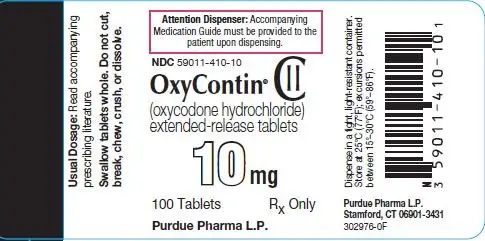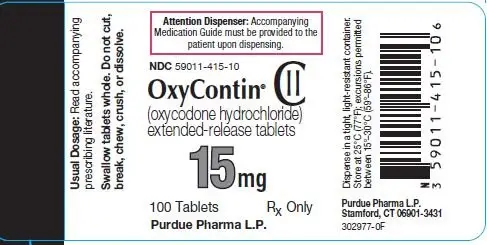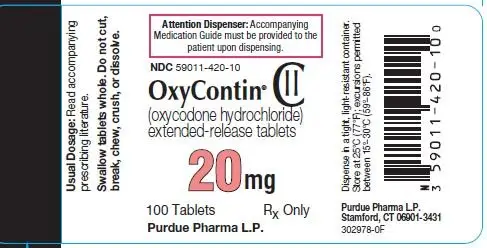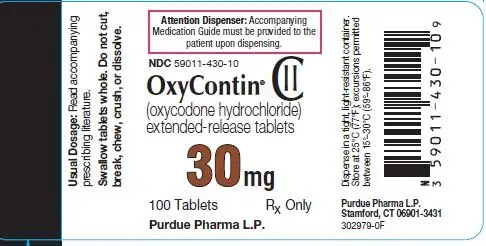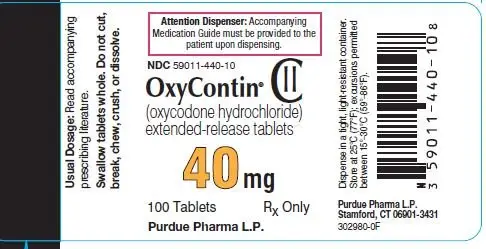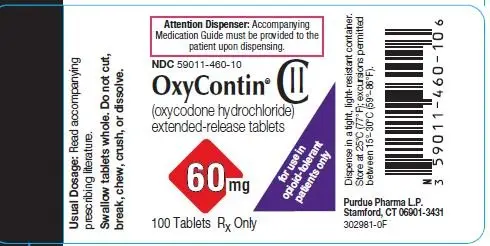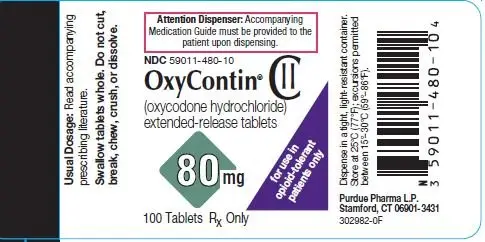Drug Detail:Oxycontin (Oxycodone [ ox-i-koe-done ])
Drug Class: Opioids (narcotic analgesics)
Highlights of Prescribing Information
OXYCONTIN® (oxycodone hydrochloride) extended-release tablets, for oral use, CII
Initial U.S. Approval: 1950
WARNING: ADDICTION, ABUSE AND MISUSE;
RISK EVALUATION AND MITIGATION STRATEGY (REMS); LIFE-THREATENING RESPIRATORY
DEPRESSION; ACCIDENTAL INGESTION; NEONATAL OPIOID WITHDRAWAL SYNDROME;
CYTOCHROME P450 3A4 INTERACTION; and RISKS FROM CONCOMITANT USE WITH
BENZODIAZEPINES OR OTHER CNS DEPRESSANTS
See full prescribing information for complete boxed warning.
- OXYCONTIN exposes users to risks of addiction, abuse and misuse, which can lead to overdose and death. Assess patient’s risk before prescribing and monitor regularly for these behaviors and conditions. (5.1)
- To ensure that the benefits of opioid analgesics outweigh the risks of addiction, abuse, and misuse, the Food and Drug Administration (FDA) has required a Risk Evaluation and Mitigation Strategy (REMS) for these products. (5.2)
- Serious, life-threatening, or fatal respiratory depression may occur. Monitor closely, especially upon initiation or following a dose increase. Instruct patients to swallow OXYCONTIN tablets whole to avoid exposure to a potentially fatal dose of oxycodone. (5.3)
- Accidental ingestion of OXYCONTIN, especially by children, can result in a fatal overdose of oxycodone. (5.3)
- Prolonged use of OXYCONTIN during pregnancy can result in neonatal opioid withdrawal syndrome, which may be life-threatening if not recognized and treated. If prolonged opioid use is required in a pregnant woman, advise the patient of the risk of neonatal opioid withdrawal syndrome and ensure that appropriate treatment will be available. (5.4)
- Concomitant use with CYP3A4 inhibitors (or discontinuation of CYP3A4 inducers) can result in a fatal overdose of oxycodone. (5.5, 7, 12.3)
- Concomitant use of opioids with benzodiazepines or other central nervous system (CNS) depressants, including alcohol, may result in profound sedation, respiratory depression, coma, and death. Reserve concomitant prescribing for use in patients for whom alternative treatment options are inadequate; limit dosages and durations to the minimum required; and follow patients for signs and symptoms of respiratory depression and sedation. (5.6, 7)
Recent Major Changes
Indications and Usage for OxyContin
OXYCONTIN is an opioid agonist indicated for the management of pain severe enough to require daily, around-the-clock, long-term opioid treatment and for which alternative treatment options are inadequate in:
- Adults; and
- Opioid-tolerant pediatric patients 11 years of age and older who are already receiving and tolerate a minimum daily opioid dose of at least 20 mg oxycodone orally or its equivalent.
Limitations of Use
- Because of the risks of addiction, abuse and misuse with opioids, even at recommended doses, and because of the greater risks of overdose and death with extended-release opioid formulations, reserve OXYCONTIN for use in patients for whom alternative treatment options (e.g. non-opioid analgesics or immediate-release opioids) are ineffective, not tolerated, or would be otherwise inadequate to provide sufficient management of pain. (1)
- OXYCONTIN is not indicated as an as-needed (prn) analgesic. (1)
OxyContin Dosage and Administration
- To be prescribed only by healthcare providers knowledgeable in use of potent opioids for management of chronic pain. (2.1)
- OXYCONTIN 60 mg and 80 mg tablets, a single dose greater than 40 mg, or a total daily dose greater than 80 mg are only for use in patients in whom tolerance to an opioid of comparable potency has been established. (2.1)
- Patients considered opioid-tolerant are those taking, for one week or longer, at least 60 mg oral morphine per day, 25 mcg transdermal fentanyl per hour, 30 mg oral oxycodone per day, 8 mg oral hydromorphone per day, 25 mg oral oxymorphone per day, 60 mg oral hydrocodone per day, or an equianalgesic dose of another opioid. (2.1)
- Use the lowest effective dosage for the shortest duration consistent with individual patient treatment goals. (2.1)
- Individualize dosing based on the severity of pain, patient response, prior analgesic experience, and risk factors for addiction, abuse, and misuse. (2.1)
- Instruct patients to swallow tablets intact and not to cut, break, chew, crush, or dissolve tablets (risk of potentially fatal dose). (2.1, 5.1)
- Instruct patients to take tablets one at a time, with enough water to ensure complete swallowing immediately after placing in mouth. (2.1, 5.11)
- Discuss availability of naloxone with the patient and caregiver and assess each patient’s need for access to naloxone, both when initiating and renewing treatment with OXYCONTIN. Consider prescribing naloxone based on the patient’s risk factors for overdose (2.2, 5.1, 5.3, 5.6).
- Do not abruptly discontinue OXYCONTIN in a physically dependent patient because rapid discontinuation of opioid analgesics has resulted in serious withdrawal symptoms, uncontrolled pain, and suicide. (2.10)
Adults: For opioid-naïve and opioid non-tolerant patients, initiate with 10 mg tablets orally every 12 hours. See full prescribing information for instructions on conversion from opioids to OXYCONTIN, titration and maintenance of therapy. (2.3, 2.4, 2.6)
Pediatric Patients 11 Years of Age and Older
- For use only in pediatric patients 11 years and older already receiving and tolerating opioids for at least 5 consecutive days with a minimum of 20 mg per day of oxycodone or its equivalent for at least two days immediately preceding dosing with OXYCONTIN. (2.5)
- See full prescribing information for instructions on conversion from opioids to OXYCONTIN, titration and maintenance of therapy. (2.5, 2.6)
Geriatric Patients: In debilitated, opioid non-tolerant geriatric patients, initiate dosing at one third to one half the recommended starting dosage and titrate carefully. (2.8, 8.5)
Patients with Hepatic Impairment: Initiate dosing at one third to one half the recommended starting dosage and titrate carefully. (2.9, 8.6)
Dosage Forms and Strengths
Extended-release tablets: 10 mg, 15 mg, 20 mg, 30 mg, 40 mg, 60 mg, and 80 mg. (3)
Contraindications
- Significant respiratory depression (4)
- Acute or severe bronchial asthma in an unmonitored setting or in absence of resuscitative equipment (4)
- Known or suspected gastrointestinal obstruction, including paralytic ileus (4)
- Hypersensitivity to oxycodone (4)
Warnings and Precautions
- Life-Threatening Respiratory Depression in Patients with Chronic Pulmonary Disease or in Elderly, Cachectic, or Debilitated Patients: Monitor closely, particularly during initiation and titration. (5.7)
- Adrenal Insufficiency: If diagnosed, treat with physiologic replacement of corticosteroids, and wean patient off of the opioid. (5.8)
- Severe Hypotension: Monitor during dosage initiation and titration. Avoid use of OXYCONTIN in patients with circulatory shock. (5.9)
- Risks of Use in Patients with Increased Intracranial Pressure, Brain Tumors, Head Injury, or Impaired Consciousness: Monitor for sedation and respiratory depression. Avoid use of OXYCONTIN in patients with impaired consciousness or coma. (5.10)
- Risk of Obstruction in Patients who have Difficulty Swallowing or have Underlying GI Disorders that may Predispose them to Obstruction: Consider use of an alternative analgesic. (5.11)
Adverse Reactions/Side Effects
Most common adverse reactions (incidence >5%) were constipation, nausea, somnolence, dizziness, vomiting, pruritus, headache, dry mouth, asthenia, and sweating. (6.1)
To report SUSPECTED ADVERSE REACTIONS, contact Purdue Pharma L.P. at 1-888-726-7535 or FDA at 1-800-FDA-1088 or www.fda.gov/medwatch.
Drug Interactions
- CNS Depressants: Concomitant use may cause hypotension, profound sedation, respiratory depression, coma, and death. If co-administration is required and the decision to begin OXYCONTIN is made, start with 1/3 to 1/2 the recommended starting dosage, consider using a lower dosage of the concomitant CNS depressant, and monitor closely. (2.7, 5.6, 7)
- Serotonergic Drugs: Concomitant use may result in serotonin syndrome. Discontinue OXYCONTIN if serotonin syndrome is suspected. (7)
- Mixed Agonist/Antagonist and Partial Agonist Opioid Analgesics: Avoid use with OXYCONTIN because they may reduce analgesic effect of OXYCONTIN or precipitate withdrawal symptoms. (5.14, 7)
- Monoamine Oxidase Inhibitors (MAOIs): Can potentiate the effects of morphine. Avoid concomitant use in patients receiving MAOIs or within 14 days of stopping treatment with an MAOI. (7)
Use In Specific Populations
Pregnancy: May cause fetal harm.(8.1)
Lactation: Not recommended. (8.2)
See 17 for PATIENT COUNSELING INFORMATION and Medication Guide.
Revised: 10/2021
Full Prescribing Information
WARNING: ADDICTION, ABUSE AND MISUSE; RISK EVALUATION AND MITIGATION STRATEGY (REMS); LIFE-THREATENING RESPIRATORY DEPRESSION; ACCIDENTAL INGESTION; NEONATAL OPIOID WITHDRAWAL SYNDROME; CYTOCHROME P450 3A4 INTERACTION; and RISKS FROM CONCOMITANT USE WITH BENZODIAZEPINES OR OTHER CNS DEPRESSANTS
- complete a REMS-compliant education program,
- counsel patients and/or their caregivers, with every prescription, on safe use, serious risks, storage, and disposal of these products,
- emphasize to patients and their caregivers the importance of reading the Medication Guide every time it is provided by their pharmacist, and
- consider other tools to improve patient, household, and community safety.
- Reserve concomitant prescribing of OXYCONTIN and benzodiazepines or other CNS depressants for use in patients for whom alternative treatment options are inadequate.
- Limit dosages and durations to the minimum required.
- Follow patients for signs and symptoms of respiratory depression and sedation.
1. Indications and Usage for OxyContin
- Adults; and
- Opioid-tolerant pediatric patients 11 years of age and older who are already receiving and tolerate a minimum daily opioid dose of at least 20 mg oxycodone orally or its equivalent.
- Because of the risks of addiction, abuse, and misuse with opioids, even at recommended doses, and because of the greater risks of overdose and death with extended-release opioid formulations [see Warnings and Precautions (5.1)], reserve OXYCONTIN for use in patients for whom alternative treatment options (e.g., non-opioid analgesics or immediate-release opioids) are ineffective, not tolerated, or would be otherwise inadequate to provide sufficient management of pain.
- OXYCONTIN is not indicated as an as-needed (prn) analgesic.
2. OxyContin Dosage and Administration
2.1 Important Dosage and Administration Instructions
- Use the lowest effective dosage for the shortest duration
consistent with individual patient treatment goals [see Warnings
and Precautions (5)].
- Initiate the dosing regimen for each patient individually;
taking into account the patient's severity of pain, patient response,
prior analgesic treatment experience, and risk factors for addiction,
abuse, and misuse [see Warnings and Precautions (5.1)]
- Monitor patients closely for respiratory depression, especially within the first 24-72 hours of initiating therapy and following dosage increases with OXYCONTIN and adjust the dosage accordingly [see Warnings and Precautions (5.3)].
2.5 Initial Dosage in Pediatric Patients 11 Years and Older
Discontinue all other around-the-clock opioid drugs when OXYCONTIN therapy is initiated.
Consider the following when using the information in Table 1.
- This is not a table of equianalgesic doses.
- The conversion factors in this table are only for the conversion from one of the listed oral opioid analgesics to OXYCONTIN.
- The table cannot be used to convert from OXYCONTIN to another
opioid. Doing so will result in an over-estimation of the dose of
the new opioid and may result in fatal overdose.
- The formula for conversion from prior opioids, including oral oxycodone, to the daily dose of OXYCONTIN is mg per day of prior opioid x factor = mg per day of OXYCONTIN. Divide the calculated total daily dose by 2 to get the every-12-hour OXYCONTIN dose. If rounding is necessary, always round the dose down to the nearest OXYCONTIN tablet strength available.
| *For patients receiving high-dose parenteral opioids, a more conservative conversion is warranted. For example, for high-dose parenteral morphine, use 1.5 instead of 3 as a multiplication factor. | ||
| Prior Opioid | Conversion Factor | |
| Oral | Parenteral* | |
| Oxycodone | 1 | -- |
| Hydrocodone | 0.9 | -- |
| Hydromorphone | 4 | 20 |
| Morphine | 0.5 | 3 |
| Tramadol | 0.17 | 0.2 |
Step #1: To calculate the estimated total OXYCONTIN daily dosage using Table 1:
- For pediatric patients taking a single opioid, sum the current
total daily dosage of the opioid and then multiply the total daily
dosage by the approximate conversion factor to calculate the approximate
OXYCONTIN daily dosage.
- For pediatric patients on a regimen of more than one opioid,
calculate the approximate oxycodone dose for each opioid and sum the
totals to obtain the approximate OXYCONTIN daily dosage.
- For pediatric patients on a regimen of fixed-ratio opioid/non-opioid analgesic products, use only the opioid component of these products in the conversion.
3. Dosage Forms and Strengths
Extended-release tablets: 10 mg, 15 mg, 20 mg, 30 mg, 40 mg, 60 mg, and 80 mg.
- 10 mg film-coated extended-release tablets (round, white-colored, bi-convex tablets debossed with OP on one side and 10 on the other)
- 15 mg film-coated extended-release tablets (round, gray-colored, bi-convex tablets debossed with OP on one side and 15 on the other)
- 20 mg film-coated extended-release tablets (round, pink-colored, bi-convex tablets debossed with OP on one side and 20 on the other)
- 30 mg film-coated extended-release tablets (round, brown-colored, bi-convex tablets debossed with OP on one side and 30 on the other)
- 40 mg film-coated extended-release tablets (round, yellow-colored, bi-convex tablets debossed with OP on one side and 40 on the other)
- 60 mg film-coated extended-release tablets (round, red-colored, bi-convex tablets debossed with OP on one side and 60 on the other)
- 80 mg film-coated extended-release tablets (round, green-colored, bi-convex tablets debossed with OP on one side and 80 on the other)
4. Contraindications
OXYCONTIN is contraindicated in patients with:
- Significant respiratory depression [see Warnings and Precautions (5.3)]
- Acute or severe bronchial asthma in an unmonitored setting or in the absence of resuscitative equipment [see Warnings and Precautions (5.7)]
- Known or suspected gastrointestinal obstruction, including paralytic ileus [see Warnings and Precautions (5.12)]
- Hypersensitivity (e.g., anaphylaxis) to oxycodone [see Adverse Reactions (6.2)]
5. Warnings and Precautions
5.2 Opioid Analgesic Risk Evaluation and Mitigation Strategy (REMS)
- Complete a REMS-compliant education program offered by an accredited provider of continuing education (CE) or another education program that includes all the elements of the FDA Education Blueprint for Health Care Providers Involved in the Management or Support of Patients with Pain.
- Discuss the safe use, serious risks, and proper storage and disposal of opioid analgesics with patients and/or their caregivers every time these medicines are prescribed. The Patient Counseling Guide (PCG) can be obtained at this link: www.fda.gov/OpioidAnalgesicREMSPCG.
- Emphasize to patients and their caregivers the importance of reading the Medication Guide that they will receive from their pharmacist every time an opioid analgesic is dispensed to them.
- Consider using other tools to improve patient, household, and community safety, such as patient-prescriber agreements that reinforce patient-prescriber responsibilities.
5.3 Life-Threatening Respiratory Depression
Patient Access to Naloxone for the Emergency Treatment of Opioid Overdose:
5.7 Life-Threatening Respiratory Depression in Patients with Chronic Pulmonary Disease or in Elderly, Cachectic, or Debilitated Patients
5.10 Risks of Use in Patients with Increased Intracranial Pressure, Brain Tumors, Head Injury, or Impaired Consciousness
5.11 Difficulty in Swallowing and Risk for Obstruction in Patients at Risk for a Small Gastrointestinal Lumen
6. Adverse Reactions/Side Effects
The following serious adverse reactions are described elsewhere in the labeling:
- Addiction, Abuse, and Misuse [see Warnings and Precautions (5.1)]
- Life-Threatening Respiratory Depression [see Warnings and Precautions (5.3)]
- Neonatal Opioid Withdrawal Syndrome [see Warnings and Precautions (5.4)]
- Interactions With Benzodiazepines and Other CNS Depressants [see Warnings and Precautions (5.6)]
- Adrenal Insufficiency [see Warnings and Precautions (5.8)]
- Severe Hypotension [see Warnings and Precautions (5.9)]
- Gastrointestinal Adverse Reactions [see Warnings and Precautions (5.11, 5.12)]
- Seizures [see Warnings and Precautions (5.13)]
- Withdrawal [see Warnings and Precautions (5.14)]
6.1 Clinical Trial Experience
| Adverse Reaction | OXYCONTIN (n=227) | Placebo (n=45) |
| (%) | (%) | |
| Constipation | (23) | (7) |
| Nausea | (23) | (11) |
| Somnolence | (23) | (4) |
| Dizziness | (13) | (9) |
| Pruritus | (13) | (2) |
| Vomiting | (12) | (7) |
| Headache | (7) | (7) |
| Dry Mouth | (6) | (2) |
| Asthenia | (6) | - |
| Sweating | (5) | (2) |
Gastrointestinal disorders: abdominal pain, diarrhea, dyspepsia, gastritis
General disorders and administration site conditions: chills, fever
Metabolism and nutrition disorders: anorexia
Musculoskeletal and connective tissue disorders: twitching
Respiratory, thoracic and mediastinal disorders: dyspnea, hiccups
Skin and subcutaneous tissue disorders: rash
Vascular disorders: postural hypotension
The following adverse reactions occurred in less than 1% of patients involved in clinical trials:
Blood and lymphatic system disorders: lymphadenopathy
Ear and labyrinth disorders: tinnitus
Eye disorders: abnormal vision
Injury, poisoning and procedural complications: accidental injury
Metabolism and nutrition disorders: dehydration
Psychiatric disorders: depression, agitation, depersonalization, emotional lability, hallucination
Renal and urinary disorders: dysuria, hematuria, polyuria, urinary retention
Reproductive system and breast disorders: impotence
Respiratory, thoracic and mediastinal disorders: cough increased, voice alteration
Skin and subcutaneous tissue disorders: dry skin, exfoliative dermatitis
Clinical Trial Experience in Pediatric Patients 11 Years and Older
| System Organ Class Preferred Term | 11 to 16
Years (N=140) n (%) |
|
| Any Adverse Event >= 5% | 71 (51) | |
| GASTROINTESTINAL DISORDERS | 56 (40) | |
| Vomiting | 30 (21) | |
| Nausea | 21 (15) | |
| Constipation | 13 (9) | |
| Diarrhea | 8 (6) | |
| GENERAL DISORDERS AND ADMINISTRATION SITE CONDITIONS | 32 (23) | |
| Pyrexia | 15 (11) | |
| METABOLISM AND NUTRITION DISORDERS | 9 (6) | |
| Decreased appetite | 7 (5) | |
| NERVOUS SYSTEM DISORDERS | 37 (26) | |
| Headache | 20 (14) | |
| Dizziness | 12 (9) | |
| SKIN AND SUBCUTANEOUS TISSUE DISORDERS | 23 (16) | |
| Pruritus | 8 (6) | |
Blood and lymphatic system disorders: febrile neutropenia, neutropenia
Cardiac disorders: tachycardia
Gastrointestinal disorders: abdominal pain, gastroesophageal reflux disease
General disorders and administration site conditions: fatigue, pain, chills, asthenia
Injury, poisoning, and procedural complications: procedural pain, seroma
Metabolic and nutrition disorders: hypochloremia, hyponatremia
Musculoskeletal and connective tissue disorders: pain in extremity, musculoskeletal pain
Nervous system disorders: somnolence, hypoesthesia, lethargy, paresthesia
Psychiatric disorders: insomnia, anxiety, depression, agitation
Renal and urinary disorders: dysuria, urinary retention
Respiratory, thoracic, and mediastinal disorders: oropharyngeal pain
7. Drug Interactions
Table 4 includes clinically significant drug interactions with OXYCONTIN.
| Inhibitors of CYP3A4 and CYP2D6 | |
| Clinical Impact: | The concomitant
use of OXYCONTIN and CYP3A4 inhibitors can increase the plasma concentration
of oxycodone, resulting in increased or prolonged opioid effects.
These effects could be more pronounced with concomitant use of OXYCONTIN
and CYP2D6 and CYP3A4 inhibitors, particularly when an inhibitor is
added after a stable dose of OXYCONTIN is achieved [see Warnings
and Precautions (5.5)]. After stopping a CYP3A4 inhibitor, as the effects of the inhibitor decline, the oxycodone plasma concentration will decrease [see Clinical Pharmacology (12.3)], resulting in decreased opioid efficacy or a withdrawal syndrome in patients who had developed physical dependence to oxycodone. |
| Intervention: | If concomitant
use is necessary, consider dosage reduction of OXYCONTIN until stable
drug effects are achieved. Monitor patients for respiratory depression
and sedation at frequent intervals. If a CYP3A4 inhibitor is discontinued, consider increasing the OXYCONTIN dosage until stable drug effects are achieved. Monitor for signs of opioid withdrawal. |
| Examples | Macrolide antibiotics (e.g., erythromycin), azole-antifungal agents (e.g. ketoconazole), protease inhibitors (e.g., ritonavir) |
| CYP3A4 Inducers | |
| Clinical Impact: | The concomitant
use of OXYCONTIN and CYP3A4 inducers can decrease the plasma concentration
of oxycodone [see Clinical Pharmacology (12.3)], resulting in decreased
efficacy or onset of a withdrawal syndrome in patients who have developed
physical dependence to oxycodone [see Warnings and Precautions
(5.5)]. After stopping a CYP3A4 inducer, as the effects of the inducer decline, the oxycodone plasma concentration will increase [see Clinical Pharmacology (12.3)], which could increase or prolong both the therapeutic effects and adverse reactions, and may cause serious respiratory depression. |
| Intervention:
| If concomitant use is necessary, consider increasing the OXYCONTIN dosage until stable drug effects are achieved. Monitor for signs of opioid withdrawal. If a CYP3A4 inducer is discontinued, consider OXYCONTIN dosage reduction and monitor for signs of respiratory depression. |
| Examples: | Rifampin, carbamazepine, phenytoin |
| Benzodiazepines and Other Central Nervous System (CNS) Depressants | |
| Clinical Impact: | Due to additive pharmacologic effect, the concomitant use of benzodiazepines or other CNS depressants, including alcohol, can increase the risk of hypotension, respiratory depression, profound sedation, coma, and death. |
| Intervention: | Reserve concomitant prescribing of these drugs for use in patients for whom alternative treatment options are inadequate. Limit dosages and durations to the minimum required. Follow patients closely for signs of respiratory depression and sedation. If concomitant use is warranted, consider prescribing naloxone for the emergency treatment of opioid overdose [see Dosage and Administration (2.2, 2.7), Warnings and Precautions (5.1, 5.3, 5.6)]. |
| Examples: | Benzodiazepines and other sedatives/hypnotics, anxiolytics, tranquilizers, muscle relaxants, general anesthetics, antipsychotics, other opioids, alcohol. |
| Serotonergic Drugs | |
| Clinical Impact: | The concomitant use of opioids with other drugs that affect the serotonergic neurotransmitter system has resulted in serotonin syndrome. |
| Intervention: | If concomitant use is warranted, carefully observe the patient, particularly during treatment initiation and dose adjustment. Discontinue OXYCONTIN if serotonin syndrome is suspected. |
| Examples: | Selective serotonin reuptake inhibitors (SSRIs), serotonin and norepinephrine reuptake inhibitors (SNRIs), tricyclic antidepressants (TCAs), triptans, 5-HT3 receptor antagonists, drugs that affect the serotonin neurotransmitter system (e.g., mirtazapine, trazodone, tramadol), certain muscle relaxants (i.e., cyclobenzaprine, metaxalone), monoamine oxidase (MAO) inhibitors (those intended to treat psychiatric disorders and also others, such as linezolid and intravenous methylene blue). |
| Monoamine Oxidase Inhibitors (MAOIs) | |
| Clinical Impact: | MAOI interactions with opioids may manifest as serotonin syndrome or opioid toxicity (e.g., respiratory depression, coma) [see Warnings and Precautions (5.3)]. |
| Intervention: | The use of OXYCONTIN is not recommended for patients taking MAOIs or within 14 days of stopping such treatment. |
| Examples: | phenelzine, tranylcypromine, linezolid |
| Mixed Agonist/Antagonist and Partial Agonist Opioid Analgesics | |
| Clinical Impact: | May reduce the analgesic effect of OXYCONTIN and/or precipitate withdrawal symptoms. |
| Intervention: | Avoid concomitant use. |
| Examples: | butorphanol, nalbuphine, pentazocine, buprenorphine |
| Muscle Relaxants | |
| Clinical Impact: | Oxycodone may enhance the neuromuscular blocking action of skeletal muscle relaxants and produce an increased degree of respiratory depression. |
| Intervention: | Monitor patients for signs of respiratory depression that may be greater than otherwise expected and decrease the dosage of OXYCONTIN and/or the muscle relaxant as necessary. Due to the risk of respiratory depression with concomitant use of skeletal muscle relaxants and opioids, consider prescribing naloxone for the emergency treatment of opioid overdose [see Dosage and Administration (2.2), Warnings and Precautions (5.3, 5.6)] |
| Examples: | Cyclobenzaprine, metaxalone |
| Diuretics | |
| Clinical Impact: | Opioids can reduce the efficacy of diuretics by inducing the release of antidiuretic hormone. |
| Intervention: | Monitor patients for signs of diminished diuresis and/or effects on blood pressure and increase the dosage of the diuretic as needed. |
| Anticholinergic Drugs | |
| Clinical Impact: | The concomitant use of anticholinergic drugs may increase risk of urinary retention and/or severe constipation, which may lead to paralytic ileus. |
| Intervention: | Monitor patients for signs of urinary retention or reduced gastric motility when OXYCONTIN is used concomitantly with anticholinergic drugs. |
8. Use In Specific Populations
9. Drug Abuse and Dependence
9.2 Abuse
| * Bipolar scales (0 = maximum negative response, 50 = neutral response, 100 = maximum positive response) | ||||
| VAS Scale (100 mm)* | OXYCONTIN (finely crushed) | Original OxyContin (finely crushed) | Oxycodone HCl (powdered) |
|
| Drug Liking | Mean (SE) | 80.4 (3.9) | 94.0 (2.7) | 89.3 (3.1) |
| Median (Range) | 88 (36-100) | 100 (51-100) | 100 (50-100) | |
| Take Drug Again | Mean (SE) | 64.0 (7.1) | 89.6 (3.9) | 86.6 (4.4) |
| Median (Range) | 78 (0-100) | 100 (20-100) | 100 (0-100) | |

11. OxyContin Description
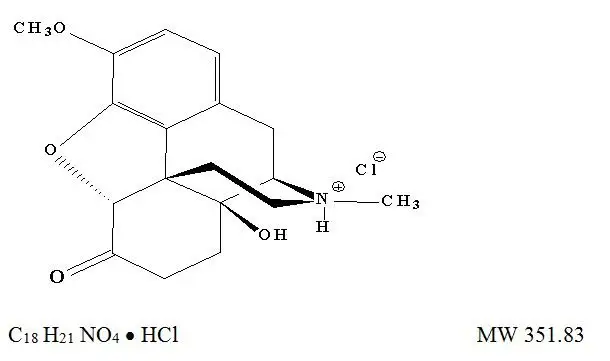
The chemical name is 4, 5α-epoxy-14-hydroxy-3-methoxy-17-methylmorphinan-6-one hydrochloride.
The 10 mg tablets also contain hydroxypropyl cellulose.
The 15 mg tablets also contain black iron oxide, yellow iron oxide, and red iron oxide.
The 20 mg tablets also contain polysorbate 80 and red iron oxide.
The 40 mg tablets also contain polysorbate 80 and yellow iron oxide.
The 60 mg tablets also contain polysorbate 80, red iron oxide and black iron oxide.
12. OxyContin - Clinical Pharmacology
12.2 Pharmacodynamics
Effects on the Central Nervous System
Effects on the Gastrointestinal Tract and Other Smooth Muscle
Effects on the Cardiovascular System
Effects on the Endocrine System
Concentration –Efficacy Relationships
12.3 Pharmacokinetics
| * for single-dose AUC = AUC0-inf
†data obtained while subjects received naltrexone, which can enhance absorption |
||||
| Regimen | Dosage Form | AUC (ng·hr/mL)* | Cmax
(ng/mL) | Tmax
(hr) |
| Single Dose† | 10 mg | 136 [27] | 11.5 [27] | 5.11 [21] |
| 15 mg | 196 [28] | 16.8 [29] | 4.59 [19] | |
| 20 mg | 248 [25] | 22.7 [25] | 4.63 [22] | |
| 30 mg | 377 [24] | 34.6 [21] | 4.61 [19] | |
| 40 mg | 497 [27] | 47.4 [30] | 4.40 [22] | |
| 60 mg | 705 [22] | 64.6 [24] | 4.15 [26] | |
| 80 mg | 908 [21] | 87.1 [29] | 4.27 [26] | |
Food has no significant effect on the extent of absorption of oxycodone from OXYCONTIN.
16. How is OxyContin supplied
Store OXYCONTIN securely and dispose of properly [see Patient Counseling Information (17)].
17. Patient Counseling Information
Advise the patient to read the FDA-approved patient labeling (Medication Guide).
Life-Threatening Respiratory Depression
Patient Access to Naloxone for the Emergency Treatment of Opioid Overdose
Educate patients and caregivers on how to recognize the signs and symptoms of an overdose.
If naloxone is prescribed, also advise patients and caregivers:
- How to treat with naloxone in the event of an opioid overdose
- To tell family and friends about their naloxone and to keep it in a place where family and friends can access it in an emergency
- To read the Patient Information (or other educational material) that will come with their naloxone. Emphasize the importance of doing this before an opioid emergency happens, so the patient and caregiver will know what to do
Interactions with Benzodiazepines or Other CNS Depressants
Important Administration Instructions
Instruct patients how to properly take OXYCONTIN, including the following:
- OXYCONTIN is designed to work properly only if swallowed intact. Taking cut, broken, chewed, crushed, or dissolved OXYCONTIN tablets can result in a fatal overdose [see Dosage and Administration (2.1)].
- OXYCONTIN tablets should be taken one tablet at a time [see Dosage and Administration (2.1)].
- Do not pre-soak, lick, or otherwise wet the tablet prior to placing in the mouth [see Dosage and Administration (2.1)].
- Take each tablet with enough water to ensure complete swallowing immediately after placing in the mouth [see Dosage and Administration (2.1)].
Important Discontinuation Instructions
- In order to avoid developing withdrawal symptoms, instruct patients not to discontinue OXYCONTIN without first discussing a tapering plan with the prescriber [see Dosage and Administration (2.10)].
Driving or Operating Heavy Machinery
| This Medication Guide has been approved by the U.S. Food and Drug Administration. | Revised: 03/2021 |
| Medication
Guide OXYCONTIN® (ox-e-KON-tin) (oxycodone hydrochloride) extended-release tablets, CII |
|
|
OXYCONTIN is:
|
|
|
Important information about OXYCONTIN:
|
|
|
Do not take OXYCONTIN if you have:
Before taking OXYCONTIN, tell your healthcare provider if you have a history of:
|
|
|
Tell your healthcare provider if you are:
|
|
|
When taking OXYCONTIN:
|
|
|
While taking OXYCONTIN DO NOT:
The possible side effects of OXYCONTIN are:
|
|
|
Get emergency medical help or call 911 right away if you have:
|
|
| These are not all the
possible side effects of OXYCONTIN. Call your doctor for medical advice
about side effects. You may report side effects to FDA at 1-800-FDA-1088. For more information go to dailymed.nlm.nih.gov Manufactured by: Purdue Pharma L.P., Stamford, CT 06901-3431, www.purduepharma.com or call 1-888-726-7535 |
|

| OXYCONTIN
oxycodone hydrochloride tablet, film coated, extended release |
|||||||||||||||||||||||||
|
|||||||||||||||||||||||||
|
|||||||||||||||||||||||||
|
|||||||||||||||||||||||||
|
|||||||||||||||||||||||||
|
|||||||||||||||||||||||||
|
|||||||||||||||||||||||||
| OXYCONTIN
oxycodone hydrochloride tablet, film coated, extended release |
|||||||||||||||||||||||||
|
|||||||||||||||||||||||||
|
|||||||||||||||||||||||||
|
|||||||||||||||||||||||||
|
|||||||||||||||||||||||||
|
|||||||||||||||||||||||||
|
|||||||||||||||||||||||||
| OXYCONTIN
oxycodone hydrochloride tablet, film coated, extended release |
|||||||||||||||||||||||||
|
|||||||||||||||||||||||||
|
|||||||||||||||||||||||||
|
|||||||||||||||||||||||||
|
|||||||||||||||||||||||||
|
|||||||||||||||||||||||||
|
|||||||||||||||||||||||||
| OXYCONTIN
oxycodone hydrochloride tablet, film coated, extended release |
|||||||||||||||||||||||||
|
|||||||||||||||||||||||||
|
|||||||||||||||||||||||||
|
|||||||||||||||||||||||||
|
|||||||||||||||||||||||||
|
|||||||||||||||||||||||||
|
|||||||||||||||||||||||||
| OXYCONTIN
oxycodone hydrochloride tablet, film coated, extended release |
|||||||||||||||||||||||||
|
|||||||||||||||||||||||||
|
|||||||||||||||||||||||||
|
|||||||||||||||||||||||||
|
|||||||||||||||||||||||||
|
|||||||||||||||||||||||||
|
|||||||||||||||||||||||||
| OXYCONTIN
oxycodone hydrochloride tablet, film coated, extended release |
|||||||||||||||||||||||||
|
|||||||||||||||||||||||||
|
|||||||||||||||||||||||||
|
|||||||||||||||||||||||||
|
|||||||||||||||||||||||||
|
|||||||||||||||||||||||||
|
|||||||||||||||||||||||||
| OXYCONTIN
oxycodone hydrochloride tablet, film coated, extended release |
|||||||||||||||||||||||||
|
|||||||||||||||||||||||||
|
|||||||||||||||||||||||||
|
|||||||||||||||||||||||||
|
|||||||||||||||||||||||||
|
|||||||||||||||||||||||||
|
|||||||||||||||||||||||||
| Labeler - Purdue Pharma LP (932323652) |
| Registrant - Purdue Pharma LP (932323652) |
| Establishment | |||
| Name | Address | ID/FEI | Business Operations |
|---|---|---|---|
| Purdue Pharmaceuticals L.P. | 132080875 | MANUFACTURE(59011-440, 59011-420, 59011-430, 59011-480, 59011-415, 59011-410, 59011-460) | |
| Establishment | |||
| Name | Address | ID/FEI | Business Operations |
|---|---|---|---|
| Anderson Packaging, Inc | 053217022 | MANUFACTURE(59011-440, 59011-420, 59011-430, 59011-480, 59011-415, 59011-410, 59011-460) | |
| Establishment | |||
| Name | Address | ID/FEI | Business Operations |
|---|---|---|---|
| Sharp Corporation | 143696495 | PACK(59011-415, 59011-420, 59011-410, 59011-480, 59011-460, 59011-430, 59011-440) | |




